The Union Crosses the Rappahannock, April 28-May 2, 1863
Introduction
Text-to-speech Audio
Images
General Joseph Hooker's plan for the Chancellorsville Campaign (map by Hal Jespersen)
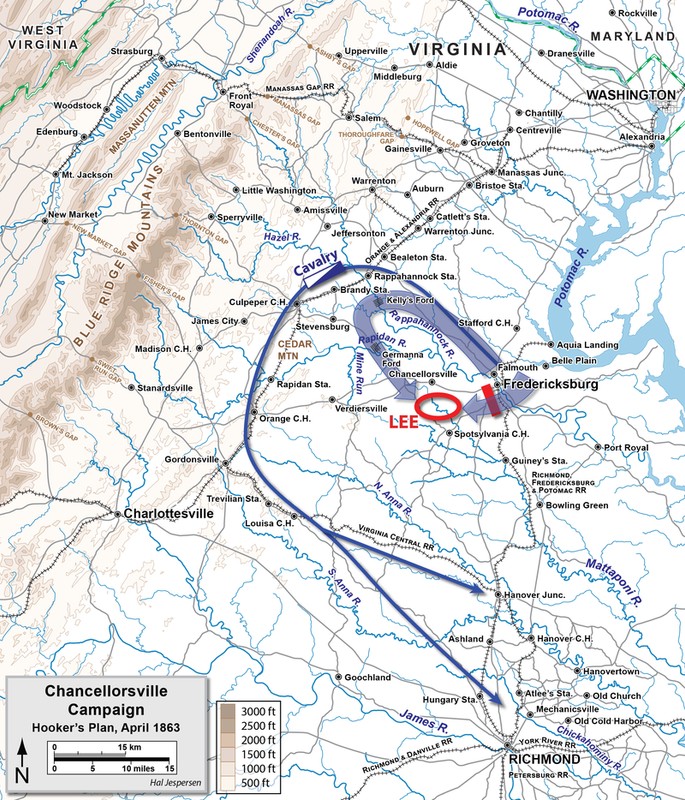
The corps of Sedgwick and Reynolds cross the Rappahannock River. (map by Kathleen Thompson)
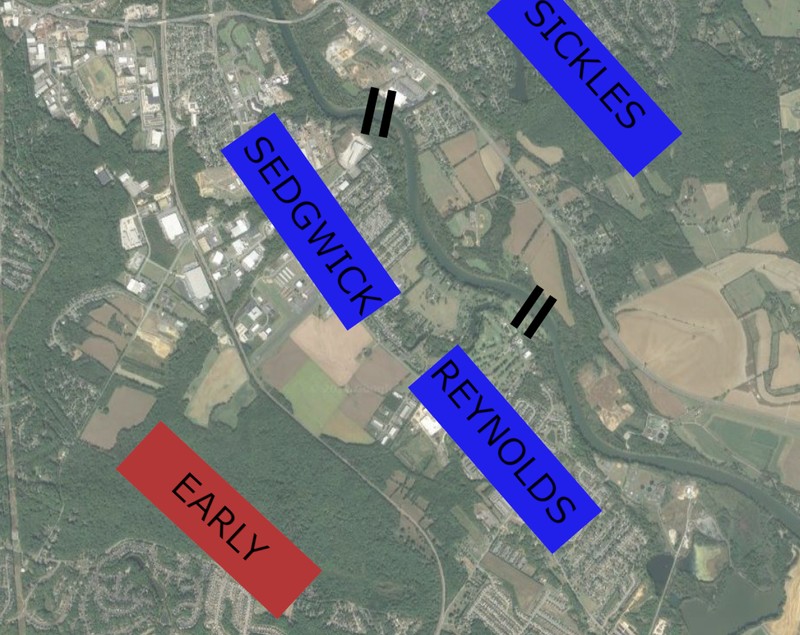
Major General John Sedgwick
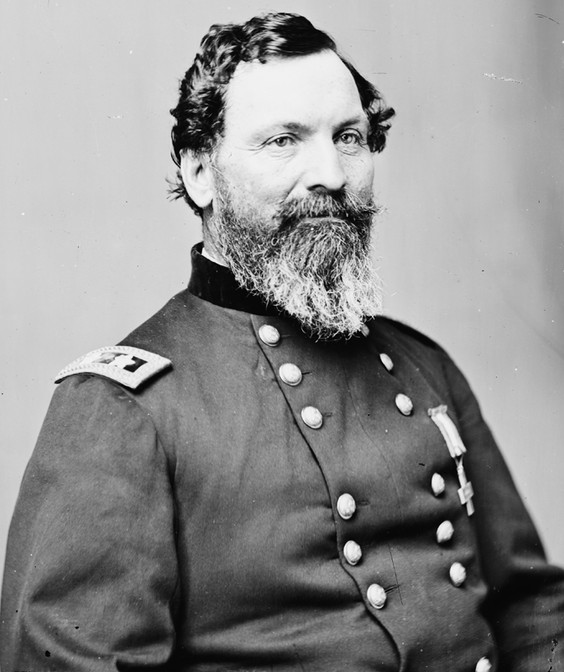
"Russells Brigade, 1st div. 6th Army Corps, crossing in Pontoons to storm the enemies rifle pits on the Rappahannock," Alfred R. Waud, April 1863
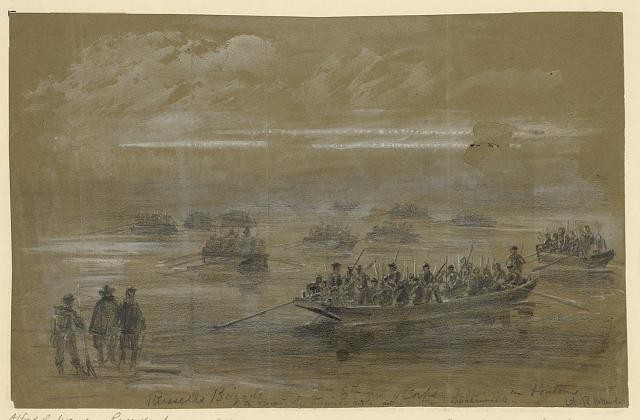
"Pontoon bridges erected for Sedgwicks corps to cross upon," Alfred R. Waud, May 1, 1863 (Library of Congress)

"Ponton [i.e. pontoon] bridges at "Franklins crossing" 2-1/2 miles below Fredericksburg, Va., laid April 29th 1863 - from plain above river bottom Bridges were laid here in Decr. 1862 & in April & June 1862 [i.e. 1863]." Photo by Andrew Russell (Library of Congress)
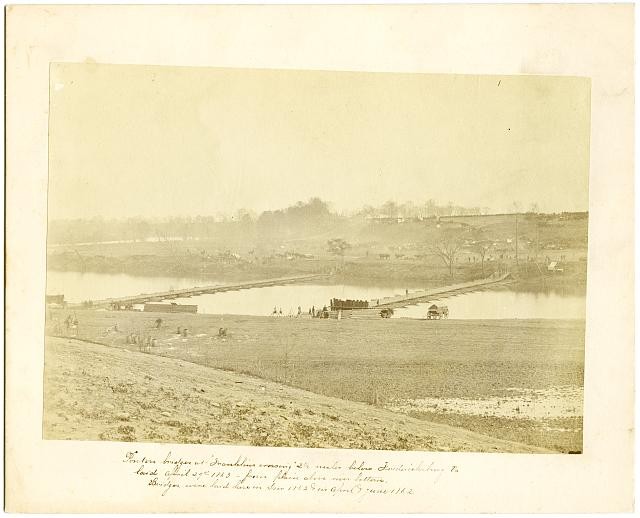
Major General John Reynolds (I Corps)
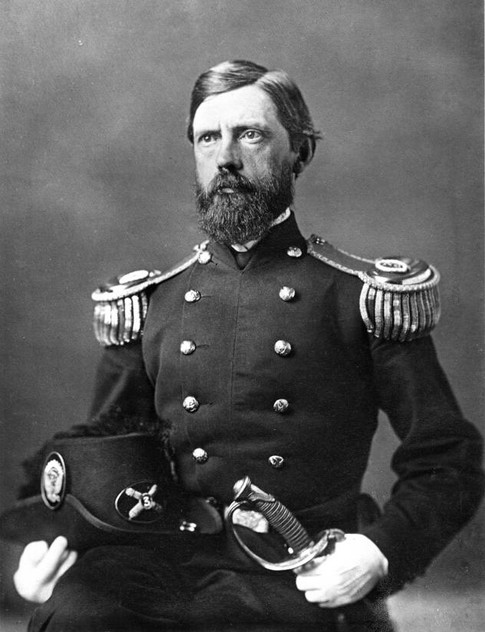
"Bridges built for Reynolds Corps, sketched from Rebel rifle pits," Alfred R. Waud, April 28-30, 1863
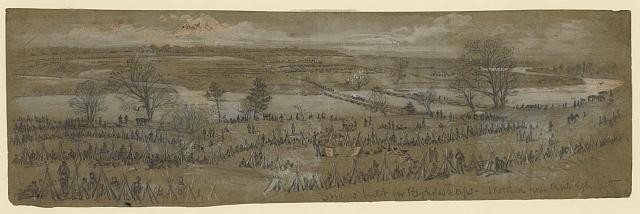
Reports of Brig. Gen. Henry W. Benham, Engineer Brigade, page 1
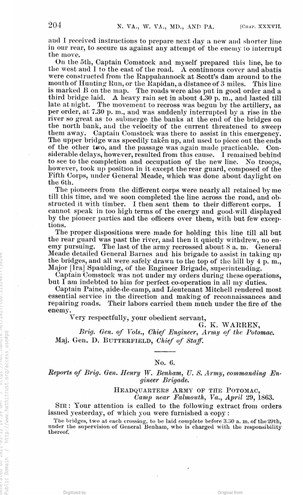
Reports of Brig. Gen. Henry W. Benham, Engineer Brigade, page 2
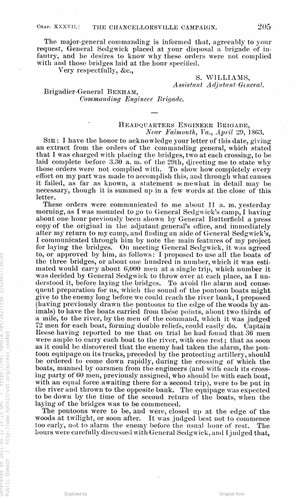
Reports of Brig. Gen. Henry W. Benham, Engineer Brigade, page 3
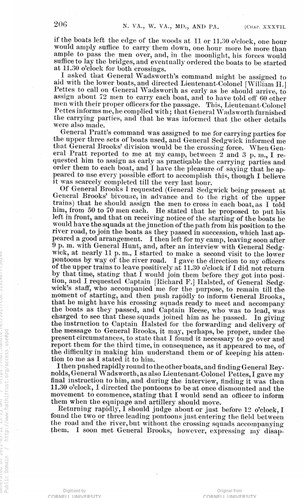
Reports of Brig. Gen. Henry W. Benham, Engineer Brigade, page 4
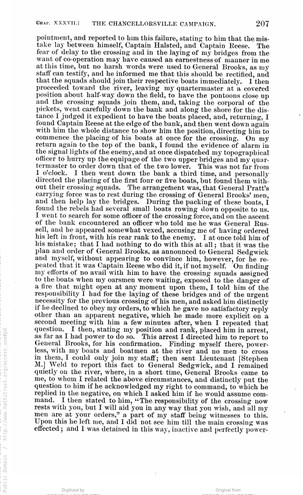
Reports of Brig. Gen. Henry W. Benham, Engineer Brigade, page 5
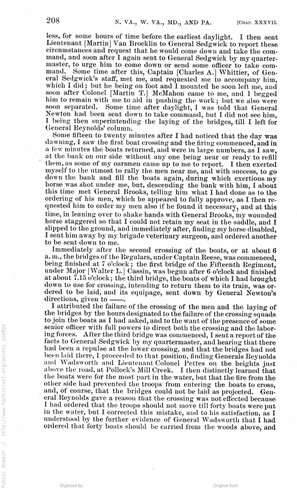
Reports of Brig. Gen. Henry W. Benham, Engineer Brigade, page 6
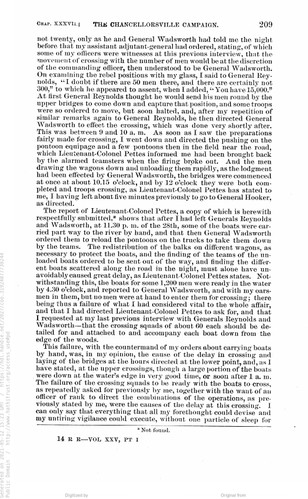
Reports of Brig. Gen. Henry W. Benham, Engineer Brigade, page 7
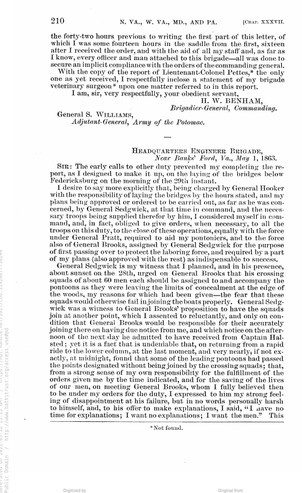
Reports of Brig. Gen. Henry W. Benham, Engineer Brigade, page 8
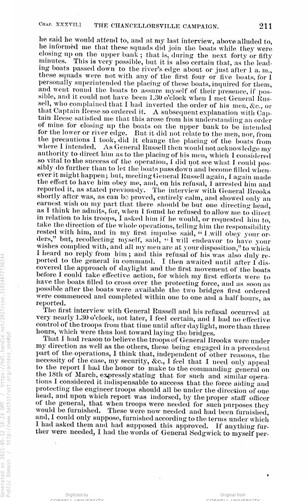
Reports of Brig. Gen. Henry W. Benham, Engineer Brigade, page 9
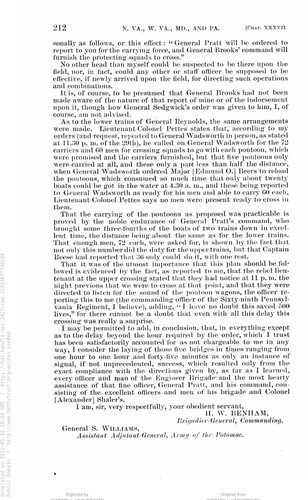
Reports of Brig. Gen. Henry W. Benham, Engineer Brigade, page 10
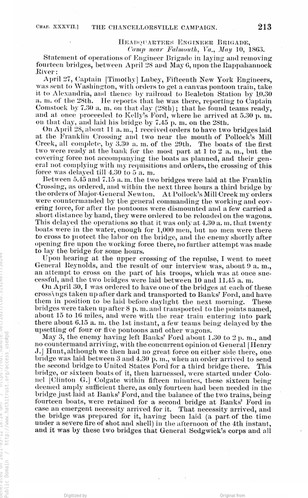
Reports of Brig. Gen. Henry W. Benham, Engineer Brigade, page 11
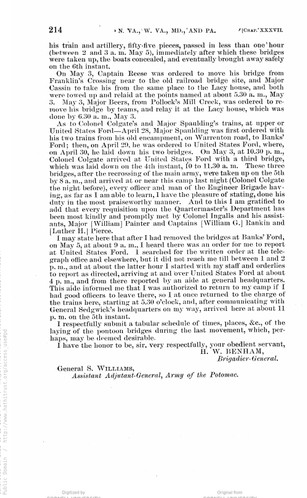
Reports of Brig. Gen. Henry W. Benham, Engineer Brigade, page 11
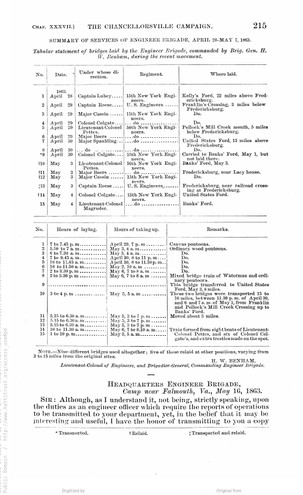
Reports of Brig. Gen. Henry W. Benham, Engineer Brigade, page 12
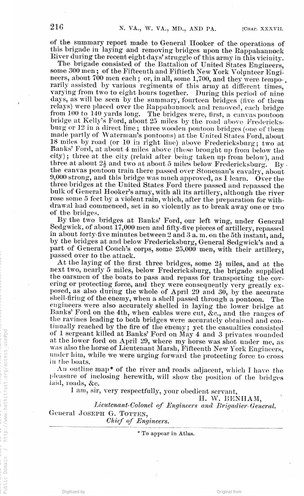
Report of Maj. Gen. John F. Reynolds, I Corps, page 1
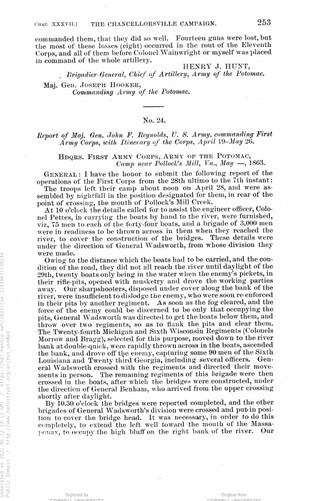
Report of Maj. Gen. John F. Reynolds, I Corps, page 2
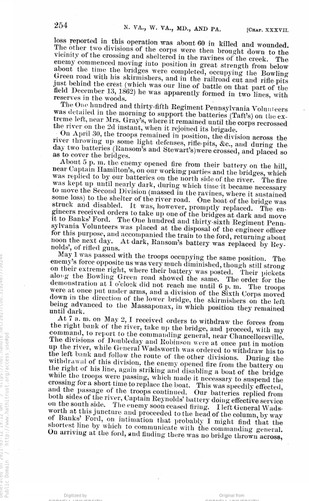
Report of Maj. Gen. John F. Reynolds, I Corps, page 3
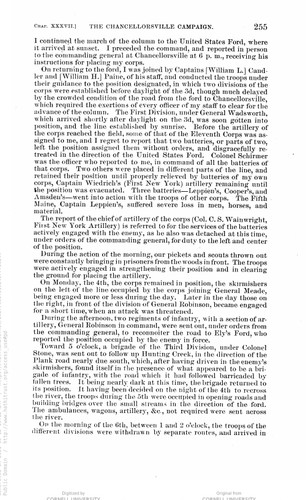
Report of Maj. Gen. John F. Reynolds, I Corps, page 4
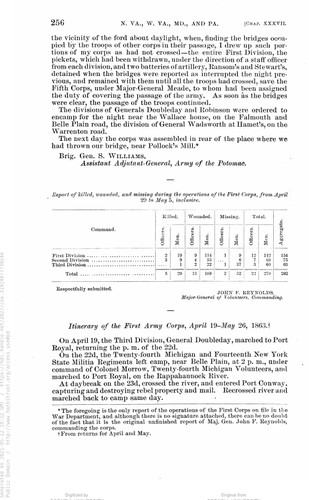
Report of Maj. Gen. John F. Reynolds, I Corps, page 5
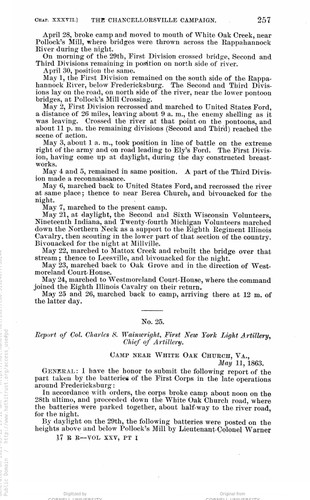
Report of Col. William W. Robinson, 7th Wisconsin, page 1
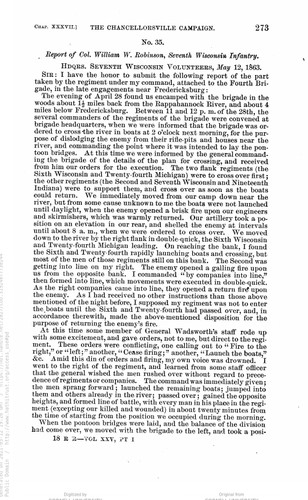
Report of Col. William W. Robinson, 7th Wisconsin, page 2
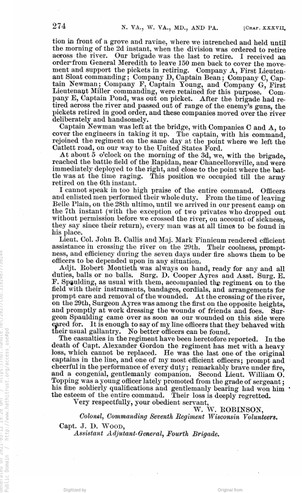
Backstory and Context
Text-to-speech Audio
In Major General Joseph Hooker’s plan for the Chancellorsville Campaign, Major General John Sedgwick would demonstrate below the city of Fredericksburg to keep the Confederate force under General Robert E. Lee in place while Hooker swung the larger portion of the Army of the Potomac north and crossed the Rappahannock River. If Hooker’s plan worked, Lee’s army would be trapped between two pincers of the Union Army and forced to retreat, or at least forced to fight outside of the entrenchments that had defeated the Federal forces in December.
Starting April 27, Hooker moved the Union V, XI, and XII Corps north from their positions around Fredericksburg and towards Kelly’s Ford on the Rappahannock. Between April 27 and April 30, these three corps crossed the Rappahannock and Rapidan Rivers and took up positions near Chancellorsville Crossroads while the II Corps secured US Mine Ford and prepared to cross in support. Meanwhile, Sedgwick was in temporary command of three corps to demonstrate against Lee at Fredericksburg (roughly 59,000 men): his VI Corps, the I Corps of Major General John Reynolds, and the III Corps of Daniel Sickles.
On April 28, 1863 Sedgwick began moving his troops into their positions. The I and VI Corps were to cross the Rappahannock south of Fredericksburg while the III Corps remained on the Stafford Heights side as reinforcements. Early in the morning of April 29 Sedwick’s IV Corps prepared to cross at Franklin’s Crossing. Men from the 15th New York Engineers, Brig. Gen. Calvin E. Pratt’s Light Division, and Col. Alexander Shaler’s brigade hand carried the pontoon boats down to the river to try to conceal the Union movements. Franklin’s Crossing was covered by artillery support on the heights (15th New York and 1st Connecticut Heavy Artillery) and on the plains (guns from the VI Corps under the command of Col. Charles H. Tompkins).
The wooden pontoon boats were 31 feet long, 5 feet wide, and weighed more than 1,200 pounds. 36 men were required to carry each boat down the slope to the edge of the river. In order to construct the needed pontoon bridges, a first wave of pontoon boats would carry troops across to clear the opposite shore and secure the anchor point for the bridge. Once the far bank was secure engineers could anchor the boats together, lash them together with beams (27-foot-long beams called balks), and lash planks (called chesses) to the beams to create the traversable bridge surface.
The first wave of pontoon boats left the eastern side of the river just before daybreak with men of the 15th New York Engineers as oarsmen. The first troops ferried across were from the brigade of Brig. Gen. David Russell: the 49th, 95th, and 119th Pennsylvania and 32nd New York. As the lead boats approached the shore, pickets from the 54th North Carolina fired on them, but the Federals were able to beach their boats and begin the work of clearing out the Confederate skirmishers at the river. Alerted to the Federal crossing, General Jubal Early advanced four brigades to the railroad embankment ahead of the Confederate entrenchments near Prospect Hill and then sent three regiments as skirmishers to a position along the Bowling Green Road (or Richmond Stage Road). By 7:00am the first pontoon bridge was complete, allowing for the First Division of Brig. Gen. William T. H. Brooks to cross and take up positions on the property of Alfred Bernard, spread down stream to the ruins of Bernard’s mansion “Mannsfield,” which had accidently burned in early April.
South of Franklin’s Crossing, Reynolds placed his Corps about a mile and a half downstream with guns of the Artillery Reserve on the high ground behind the corps and the I Corps Artillery under Col. Charles S. Wainwright close to the riverbank. The location of the I Corps crossing was Fitzhugh’s Crossing (or Pollock’s Mill Crossing) across from the ruins of Thomas Pratt’s “Smithfield.” Like Sedwick’s crossing to the north, the intention was for troops to carry the pontoon boats down to the water; however, Reynolds’ men experienced more difficulty carrying the boats down the slope. With daybreak already approaching, Reynolds abandoned secrecy for speed and ordered wagons forward to bring the pontoon boats down to the water where troops from Brig. Gen. Solomon Meredith’s brigade were already waiting to board and cross the river. It was well after daylight when the first boards reached the riverbank, and the Confederates were already aware of Sedgwick’s crossing to the north. This resulted in a much more difficult and deadly crossing for Reynold’s Corps. The 13th Georgia contested the Union crossing, slowing down the operation to get the pontoon boats into the water. Under fire, the 50th New York Engineers and 2nd Wisconsin finally got boats into the water and Meredith ordered the 6th Wisconsin and 24th Michigan into the boats to cross the river. Once the Iron Brigade men reached the western shore, the troops pushed the Confederate skirmishers back and cleared the Confederate presence from the “Smithfield” property. More troops, from Wadsworth’s division, quickly followed the first wave and the engineers could begin setting the pontoon bridges. The first bridge was completed around 10 o’clock that morning, allowing more Federal troops to cross and expand their hold on the area between the Pratt and Alsop properties.
To secure the Union left flank, Lieut. Col. Edward R. Warner (inspector of artillery, Army of the Potomac) placed sixteen guns about a mile further south from the I Corps at Traveler’s Rest. These were guns of the 5th, 15th, and 32nd New York with infantry support from the 135th Pennsylvania Volunteers. The 1st Regiment United States Sharpshooters from the III Corps were also placed at the Union flank.
For the rest of April 29 and early April 30, the I and VI Corps established their lines, dug in entrenchments, and demonstrated in front of the Confederate troops of Generals Early and Jackson. In the morning on April 30, Sedgwick received orders from Hooker to make a demonstration towards Hamilton’s Crossing at 1:00pm, but the order was cancelled later in the morning. Instead, the III Corps of Daniel Sickles was ordered to moved from its position supporting Sedgwick’s maneuver upriver to the U.S. Mine Ford and cross to join Hooker’s main force. Sedgwick’s orders to demonstrate were not restated and after dark on the 30th Hooker ordered more support shifted to the fords north of Fredericksburg. Artillery was moved to Banks’ and Scotts’ Fords and one bridge each from Franklin’s and Fitzhugh’s Crossings were dismantled and moved upstream to cross at Banks’ Ford (actually at Scott’s Ford just downstream from Banks’ Ford).
On May 1, 1863 Hooker’s swinging flank attack met the first resistance from the Confederates which stopped his forward momentum. Taking up positions near the Chancellorsville Crossroads, Hooker’s main force would soon be engaged in the Battle of Chancellorsville. For most of the day, Sedgwick waited for orders from Hooker and anxiously watched for signs that the Federal forces were approaching the rear of Fredericksburg as Hooker had planned. Late in the afternoon Sedgwick finally received orders to make a strong demonstration against Fredericksburg, but as soon as Sedgwick got his troops moving another order came from Hooker again canceling any demonstration.
On May 2, 1863 Sedwick received orders from Hooker’s headquarters for Reynolds’ I Corps to move towards Chancellorsville and for Sedgwick to pull up the pontoon crossings at Franklin’s and Fitzhugh’s Crossings. The I Corps did recross and pull up the bridges at Fitzhugh’s Crossing, but Sedgwick did not feel comfortable pulling up the pontoons at Franklin’s Crossing while his men were still on the west side of the Rappahannock. A few hours later more orders came from Hooker to attack if there was an opportunity, which surprised Sedgwick since Hooker had taken two out of the three corps he originally commanded. Starting around 3:00pm observers from the hot air balloons being used by Union across from Fredericksburg started to report Early’s withdrawal of troops to the west. Sedgwick was cautious because from his position he could still see Confederate troops on Prospect and Lee’s Hills and his pickets were engaging with Confederate pickets to the front of his line. With the Rappahannock behind his Corps and Confederates still active at the front, Sedgwick did not think it possible to attack.
Sources
Furgurson, Ernest B. Chancellorsville, 1863: The Souls of the Brave. New York: Vintage Books, 1992.
Gallagher, Gary W. The Battle of Chancellorsville. National Park Civil War Series. Eastern National, 2007.
Parsons, Philip W. The Union Sixth Army Corps in the Chancellorsville Campaign: A Study of the Engagements of Second Fredericksburg, Salem Church and Banks’s Ford, May 3-4, 1863. Jefferson, NC: McFarland & Company, Inc., 2006.
Sutherland, Daniel E. Fredericksburg and Chancellorsville: The Dare Mark Campaign. Lincoln: University of Nebraska Press, 1998.
"Battle of Chancellorsville." Wikipedia. Accessed May 4, 2021. https://en.wikipedia.org/wiki/Battle_of_Chancellorsville.
Map by Kathleen Thompson
"John Sedgwick." Wikipedia. Accessed May 4, 2021. https://en.wikipedia.org/wiki/John_Sedgwick
Waud, Alfred R. , Artist. Russells Brigade, 1st div. 6th Army Corps, crossing in Pontoons to storm the enemies rifle pits on the Rappahannock. United States Virginia Rappahannock River, 1863. [April] Photograph. https://www.loc.gov/item/2004660336/. Accessed May 4, 2021.
"Second Battle of Fredericksburg." Wikipedia. Accessed May 4, 2021. https://en.wikipedia.org/wiki/Second_Battle_of_Fredericksburg.
"Ponton [i.e. pontoon] bridges at "Franklins crossing" 2-1/2 miles below Fredericksburg, Va., laid April 29th 1863 - from plain above river bottom Bridges were laid here in Decr. 1862 & in April & June 1862 [i.e. 1863]." Library of Congress Prints and Photographs Division Washington, D.C. Accessed May 11, 2021. https://www.loc.gov/pictures/item/2011647796/.
"John F. Reynolds." Wikipedia. Accessed May 4, 2021. https://en.wikipedia.org/wiki/John_F._Reynolds.
Waud, Alfred R. , Artist. Bridges built for Reynolds Corps, sketched from Rebel rifle pits. United States Virginia Rappahannock River, 1863. [-30] Photograph. https://www.loc.gov/item/2004660283/. Accessed May 4, 2021.
The War of the Rebellion: A Compilation of the Official Records of the Union and Confederate Armies. Series I-Volume XXV-Part I-Reports, page 204. Accessed May 12, 2021. https://babel.hathitrust.org/cgi/pt?id=coo.31924077730244&view=1up&seq=3.
The War of the Rebellion: A Compilation of the Official Records of the Union and Confederate Armies. Series I-Volume XXV-Part I-Reports, page 205. Accessed May 12, 2021. https://babel.hathitrust.org/cgi/pt?id=coo.31924077730244&view=1up&seq=3.
The War of the Rebellion: A Compilation of the Official Records of the Union and Confederate Armies. Series I-Volume XXV-Part I-Reports, page 206. Accessed May 12, 2021. https://babel.hathitrust.org/cgi/pt?id=coo.31924077730244&view=1up&seq=3.
The War of the Rebellion: A Compilation of the Official Records of the Union and Confederate Armies. Series I-Volume XXV-Part I-Reports, page 207. Accessed May 12, 2021. https://babel.hathitrust.org/cgi/pt?id=coo.31924077730244&view=1up&seq=3.
The War of the Rebellion: A Compilation of the Official Records of the Union and Confederate Armies. Series I-Volume XXV-Part I-Reports, page 208. Accessed May 12, 2021. https://babel.hathitrust.org/cgi/pt?id=coo.31924077730244&view=1up&seq=3.
The War of the Rebellion: A Compilation of the Official Records of the Union and Confederate Armies. Series I-Volume XXV-Part I-Reports, page 209. Accessed May 12, 2021. https://babel.hathitrust.org/cgi/pt?id=coo.31924077730244&view=1up&seq=3.
The War of the Rebellion: A Compilation of the Official Records of the Union and Confederate Armies. Series I-Volume XXV-Part I-Reports, page 210. Accessed May 12, 2021. https://babel.hathitrust.org/cgi/pt?id=coo.31924077730244&view=1up&seq=3.
The War of the Rebellion: A Compilation of the Official Records of the Union and Confederate Armies. Series I-Volume XXV-Part I-Reports, page 211. Accessed May 12, 2021. https://babel.hathitrust.org/cgi/pt?id=coo.31924077730244&view=1up&seq=3.
The War of the Rebellion: A Compilation of the Official Records of the Union and Confederate Armies. Series I-Volume XXV-Part I-Reports, page 212. Accessed May 12, 2021. https://babel.hathitrust.org/cgi/pt?id=coo.31924077730244&view=1up&seq=3.
The War of the Rebellion: A Compilation of the Official Records of the Union and Confederate Armies. Series I-Volume XXV-Part I-Reports, page 213. Accessed May 12, 2021. https://babel.hathitrust.org/cgi/pt?id=coo.31924077730244&view=1up&seq=3.
The War of the Rebellion: A Compilation of the Official Records of the Union and Confederate Armies. Series I-Volume XXV-Part I-Reports, page 214. Accessed May 12, 2021. https://babel.hathitrust.org/cgi/pt?id=coo.31924077730244&view=1up&seq=3.
The War of the Rebellion: A Compilation of the Official Records of the Union and Confederate Armies. Series I-Volume XXV-Part I-Reports, page 215. Accessed May 12, 2021. https://babel.hathitrust.org/cgi/pt?id=coo.31924077730244&view=1up&seq=3.
The War of the Rebellion: A Compilation of the Official Records of the Union and Confederate Armies. Series I-Volume XXV-Part I-Reports, page 216. Accessed May 12, 2021. https://babel.hathitrust.org/cgi/pt?id=coo.31924077730244&view=1up&seq=3.
The War of the Rebellion: A Compilation of the Official Records of the Union and Confederate Armies. Series I-Volume XXV-Part I-Reports, page 253. Accessed May 12, 2021. https://babel.hathitrust.org/cgi/pt?id=coo.31924077730244&view=1up&seq=3.
The War of the Rebellion: A Compilation of the Official Records of the Union and Confederate Armies. Series I-Volume XXV-Part I-Reports, page 254. Accessed May 12, 2021. https://babel.hathitrust.org/cgi/pt?id=coo.31924077730244&view=1up&seq=3.
The War of the Rebellion: A Compilation of the Official Records of the Union and Confederate Armies. Series I-Volume XXV-Part I-Reports, page 255. Accessed May 12, 2021. https://babel.hathitrust.org/cgi/pt?id=coo.31924077730244&view=1up&seq=3.
The War of the Rebellion: A Compilation of the Official Records of the Union and Confederate Armies. Series I-Volume XXV-Part I-Reports, page 256. Accessed May 12, 2021. https://babel.hathitrust.org/cgi/pt?id=coo.31924077730244&view=1up&seq=3.
The War of the Rebellion: A Compilation of the Official Records of the Union and Confederate Armies. Series I-Volume XXV-Part I-Reports, page 257. Accessed May 12, 2021. https://babel.hathitrust.org/cgi/pt?id=coo.31924077730244&view=1up&seq=3.
The War of the Rebellion: A Compilation of the Official Records of the Union and Confederate Armies. Series I-Volume XXV-Part I-Reports, page 273. Accessed May 12, 2021. https://babel.hathitrust.org/cgi/pt?id=coo.31924077730244&view=1up&seq=3.
The War of the Rebellion: A Compilation of the Official Records of the Union and Confederate Armies. Series I-Volume XXV-Part I-Reports, page 274. Accessed May 12, 2021. https://babel.hathitrust.org/cgi/pt?id=coo.31924077730244&view=1up&seq=3.
